Even as rival AMD continues to push forward with its 7nm silicon, Intel has so far hung on to a larger 14nm node for its desktop chips, only migrating to 10nm within this past year on mobile. Critics have lamented Intel’s stubbornness, but the company recently released a 10-year road map outlining a bullish cadence of innovation with a promising long-term outlook.
With its eyes set toward the end of the decade, Intel intends on arriving at a powerfully diminutive 1.4nm node — or just one-tenth the size of its desktop node today — by 2029. Intel hopes that its aggressive development trajectory will help it regain silicon leadership, which will be important for competition against AMD’s Ryzen processors, as well as the urge to move to ARM-based processors from companies like Apple and Microsoft.
2020 so far: Ice Lake and Comet Lake
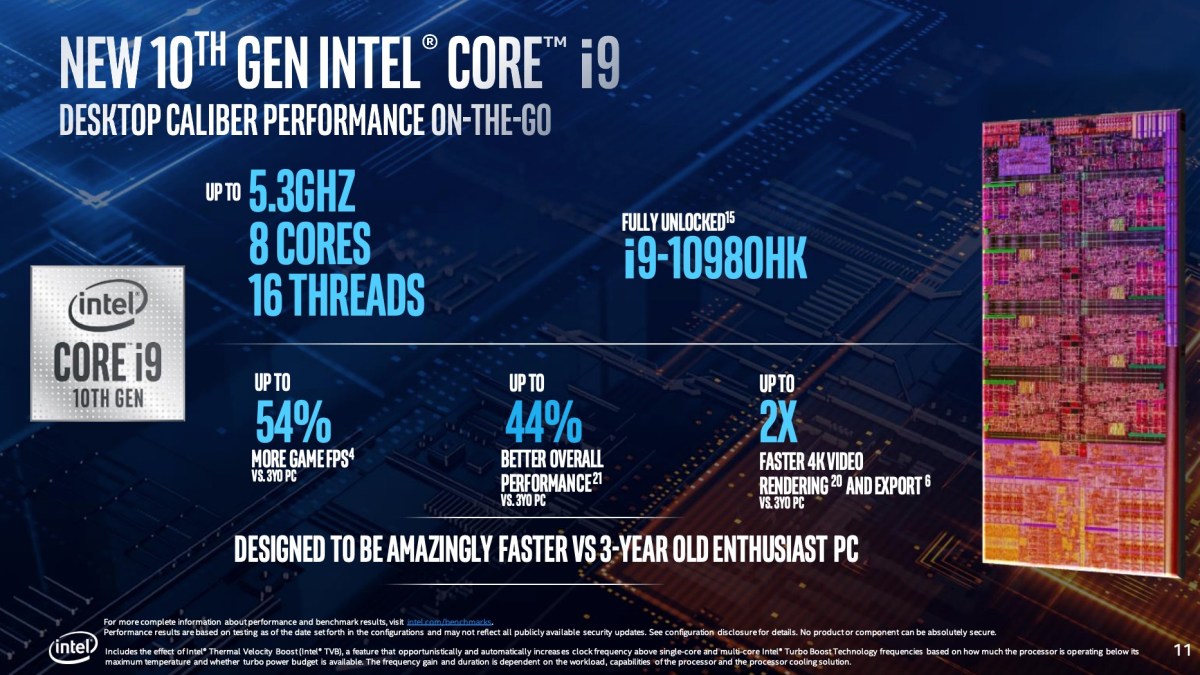
This year, Intel is continuing its rollout of the 10th-generation processor family, which began with last year’s debut of 10nm Ice Lake on thin and light laptops. in conjunction with Ice Lake Intel is also pushing ahead with its Project Athena initiative, which seeks to standardize small, portable laptops that have been certified by Intel.
One of the biggest upgrades to Intel’s Ice Lake processors was the inclusion of Gen11 integrated graphics, also known as Iris Plus.
In 2020, Intel is also still launching new versions of its 14nm architecture as well. Its 10th-gen Comet Lake H processors were launched on larger, more powerful laptops. Intel took a similar approach for desktops by introducing Comet Lake S chips.

Beyond those standard annual updates, Intel also officially unveiled its hybrid Lakefield processors, which will arrive later this year in devices with emerging form factors and are likely part of the company’s Project Athena initiative. These experimental new chips are set to arrive on foldables, such as Lenovo’s ThinkPad X1 Fold that was announced at CES in January, and on dual-screen devices like Microsoft’s Surface Neo.
Unlike traditional Intel chips, Lakefield uses a combination of architectures designed to optimize performance and battery life. The design is not unlike what ARM’s big.LITTLE chip design, as Intel looks to combine Ice Lake’s Sunny Cove microarchitecture found on the powerful Core i3 and Core i5 processors with power-efficient, Atom-based Tremont cores.
2020 to come: Tiger Lake, Xe graphics, and more
Intel typically launches its next generation of mobile processors in the fall, and this year it’s the 11th-gen Tiger Lake line. Tiger Lake could debut on September 2 at a scheduled Intel event with a 10nm++ design, though that hasn’t yet been confirmed. Compared to a 14nm design, Intel claimed that its 10nm-based nodes offer 2.7 times the density scaling. These nodes are based on first-generation Foveros 3D stacking and second-generation EMIB packaging designs.
And even though it hasn’t been formally announced, Intel had already confirmed a few of the features, including support for the new Thunderbolt 4 standard, USB4, as well as new Gen12 graphics. Also known as Intel Xe, Gen12 graphics is based on the same GPU architecture that Intel is using for its DG1 discrete graphics card. Gen12 is expected to provide twice the performance of Gen11, which will help Intel compete against rival AMD’s upcoming 7nm Navi graphics architecture.
A recent SiSoftware benchmark revealed that Gen12 graphics could go under the Intel Iris Xe branding. The benchmark also confirmed that Intel’s integrated GPU will be clocked at 1.3GHz and come with 96 EUs. In a separate Twitter post, Intel chief performance strategist Ryan Shrout showed off the capabilities of Gen12 graphics. In a video uploaded to the social networking site, Shrout showed a laptop with Gen12 graphics running at 30 frames per second with Battlefield V playing at high settings.
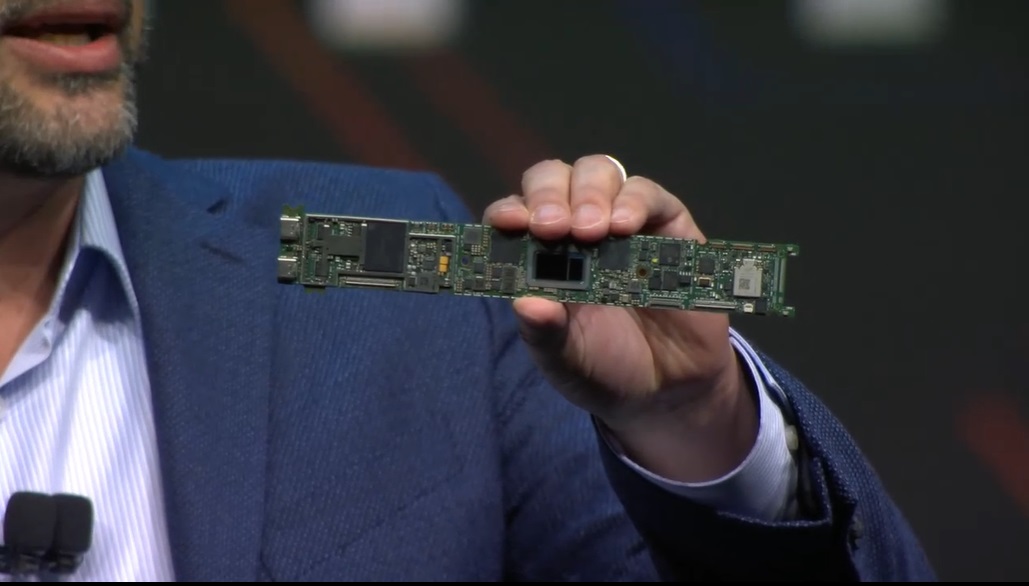
Intel had previously confirmed that Tiger Lake will come with a new processor core in a presentation on the company’s road map. The processor will likely be based on an enhanced 10nm node — 10nm+ — and feature new Willow Cove cores. Compared to 10th-gen Ice Lake, Tiger Lake is believed to arrive with up to 50% more L3 cache than Ice Lake, according to Tom’s Hardware.
While Intel will exclusively be using its Tiger Lake silicon on laptops and gaming notebooks, succeeding Comet Lake on the desktop will be the company’s Rocket Lake processor. Confusingly, however, Intel’s Rocket Lake is said to also be available on laptops. On desktop, the 11th-gen Rocket Lake S will find Intel finally migrating away from its aging 14nm Skylake architecture, which will now be in its seventh iteration. Intel’s leaked road map confirmed that opportunities exist for backporting, and industry insiders believe that the desktop silicon could use a backport of the Willow Cove design that debuted on Tiger Lake.
Intel promises better performance with Rocket Lake, and it’s believed that the CPU could deliver approximately a 25% IPC uplift compared to Comet Lake. While Rocket Lake is speculated to arrive in 2020, given Intel’s already busy release cadence, it wouldn’t surprise us to see the processor launching in early 2021.
A leaked slide obtained by Videocardz detailed that Rocket Lake may be the first Intel CPU to support PCIe 4.0. Additionally, it will use a first-tier GT1 version of Intel Xe graphics. Rocket Lake is speculated to use Intel’s hybrid microarchitecture design, combining a 10nm processor with a 14nm integrated GPU architecture.
Graphics performance is up for debate, however, as Twitter user @chiakokhua stated that Rocket Lake’s Gen12 graphics will only contain 32 execution units, compared to the 96 EUs on Tiger Lake. Intel’s silicon will also support discrete (rather than integrated) Thunderbolt 4 support.
Curiously, unlike Comet Lake, which maxes out with a 10-core Core i9 design, Rocket Lake is believed to utilize an architecture that tops out with eight and 16 threads, according to Wccftech, and the lower core count could help Intel deliver big IPC gains with this generation.
Despite retaining compatibility with the LGA1200 socket, upgradeability is still debated as Intel is also slated to launch its new 500 chipset alongside Rocket Lake. The processor series will include 15-watt Rocket Lake-U and 45-watt Rocket Lake-H on mobile, and desktop Rocket Lake-S will have TDPs between 35 and 125 watts.

Intel’s DG1 discrete graphics card, which is based on the same Gen12 integrated graphics architecture, was previewed earlier in the year at CES with Intel chief architect Raja Koduri previously hinting of a June launch, but that schedule was likely disrupted by the global coronavirus pandemic.
Consumers looking for a suitable rival to the graphics stronghold of AMD and Nvidia will have to search elsewhere, as DG1 isn’t intended for the consumer market. We are, however, still expecting Intel to launch its first consumer discrete graphics cards sometime in late 2020.
2021: A hybrid architecture approach
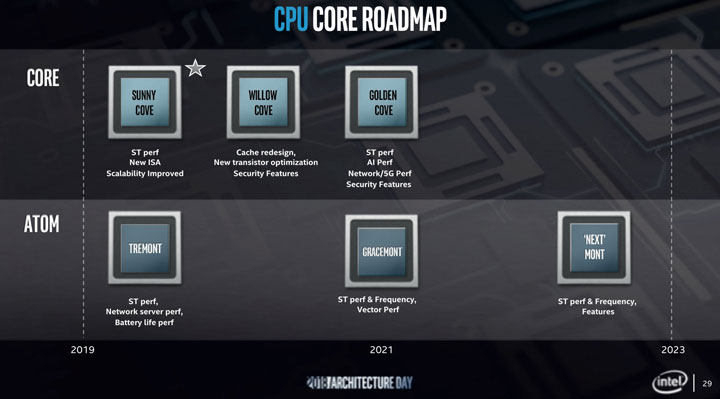
In 2021, Intel’s transition to 12th-gen will begin with Alder Lake. On desktop, the 10nm Alder Lake will likely launch towards the end of the year, representing the fourth iteration of Intel’s 10nm node. Most notably, Alder Lake S will usher in a new 10nm silicon architecture for desktops, borrowing from Lakefield’s hybrid architecture variation of ARM’s big.LITTLE design.
It’s unclear why Intel is migrating to this architecture at this point — desktops aren’t constrained by battery life requirements on mobiles running Lakefield — but one possibility is that it could allow Intel to claim more cores on its CPU lineup. Rumors suggest that Alder Lake S will combine Intel’s more powerful Willow Cove or Golden Cove cores alongside the low-powered, Atom-based Tremont or Gracemont cores, with the exact design still up for speculation.
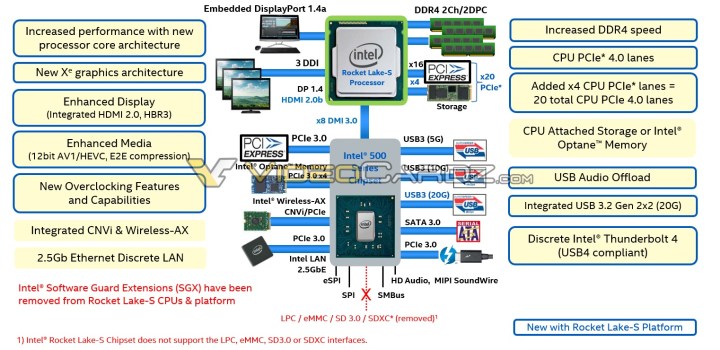
There will be multiple configurations of Alder Lake, spanning desktop and mobile, with support for varying TDPs. On desktop, Alder Lake S could arrive in a configuration with eight big cores and eight little cores or six big cores and no little cores. Both configurations will come with tier-one GT1 Xe-based graphics.
The processor is also believed to usher in support for DDR5 memory and will be compatible with Intel 600 series motherboards. With Alder Lake, Intel is said to use a mixed chiplet strategy fusing the 10nm processor with an integrated 14nm Intel Xe-based graphics, according to Videocardz.
In the high-end desktop space, or HEDT, Intel may not have a processor ready until 2021, which could leave AMD’s upcoming Ryzen 4000 Threadripper unchallenged for a while. This means that there won’t be a Cascade Lake-X successor, which launched in late 2019, until 2021.
2022: Moving to 7nm
Beyond Alder Lake, the last major code name that we have on Intel’s architecture schedule is Meteor Lake. Meteor Lake S will be Intel’s first 7nm desktop processor, which means that Intel’s shift to 7nm trails rival AMD by several years. Like Alder Lake, Meteor Lake will be a heterogenous silicon, as the company continues to push a design similar to ARM’s big.LITTLE architecture to work on both desktops and mobile.
Compared to 10nm, Intel’s 7nm process delivers twice the density and will use its next-gen Foveros and Embedded Multi-die Interconnect Bridge, or EMIB, packaging. The company expects to make use of planned intra-node optimizations as well. And with Intel claiming that its 7nm process offers superior transistor density to TSMC’s 5nm manufacturing, Meteor Lake S could potentially arrive with even more cores. The processor will be made using extreme ultraviolet lithography, or EUV.
The chipset will utilize Intel’s Golden Cove cores. Meteor Lake S will likely maintain compatibility with Alder Lake’s LGA1700 sockets, but any detail beyond this is unknown.
2023 through 2029: Journey to 1.4nm
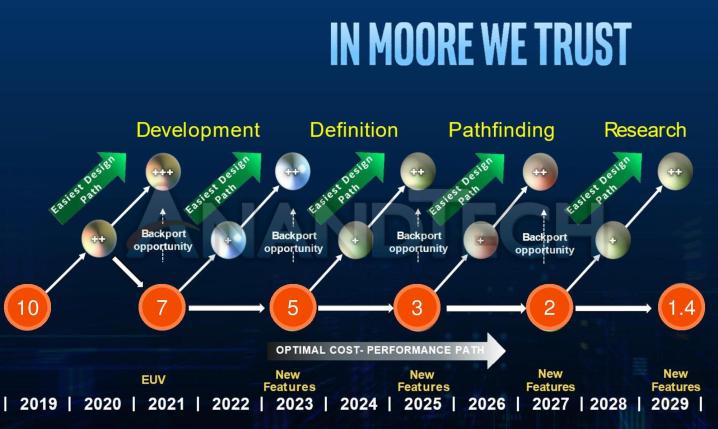
Even though we don’t have any leaked product names, it is believed that Intel will likely continue to optimize its 7nm process in 2023 and move towards 5nm in 2024 to finish the decade with 1.4nm. According to the timeline, this means that Intel’s return to a two-year cadence occurred with the launch of 10nm Ice Lake in late 2019.
Intel refers to the two-year cadence of releasing new nodes as its optimal cost to performance path, but the company also leaves room to extract more performance out of existing nodes by backporting, as detailed in a slide presented at the IEEE International Electron Devices Meeting that was obtained by Anandtech.
With each major process node, Intel will also work on enhanced + and ++ versions, which will drive even more performance out of its investment with a minimum of two optimizations. Currently with 10nm+, we’ll see 10nm++ and 10nm+++, while 7nm will get 7nm+ in 2022 and 7nm++ in 2023. Intel’s 5nm will be optimized to 5nm+ in 2024 and 5nm++ in 2025, and so on until we arrive at 2nm++ in 2029.
These iterations will happen annually, and according to the publication, Intel will have overlapping teams to ensure that the development of process nodes will overlap. The overlap will allow the ++ optimized node to launch alongside the next major node, which means that the optimized node could contain some advantages like higher clock speeds and better yields. According to this timeline, we can expect to see 7nm in 2021, 5nm in 2023 or 2024, 3nm in 2025, 2nm in 2027, and 1.4nm in 2029, Wccftech reported. The cadence of these major releases would be aggressive for Intel, given how long it has taken for the company to fully transition to 10nm across mobile and desktop.
Intel’s mention of backport opportunities in the slide is interesting, which is what is rumored currently for Rocket Lake’s architecture. Backporting would allow Intel to use a 7nm design on a 10nm+++ node, or a 5nm design on a 7nm++ node, for example. With Rocket Lake, Intel is believed to use 10nm++ Willow Cove cores on a 14nm++ architecture.
Anandtech noted that Intel was also talking about new materials and designs, so we could start seeing nano-sheets and nano-wires start appearing as Intel begins to exhaust the benefits of FinFET beyond the 7nm node, which is said to be equivalent to TSMC’s 5nm process.


